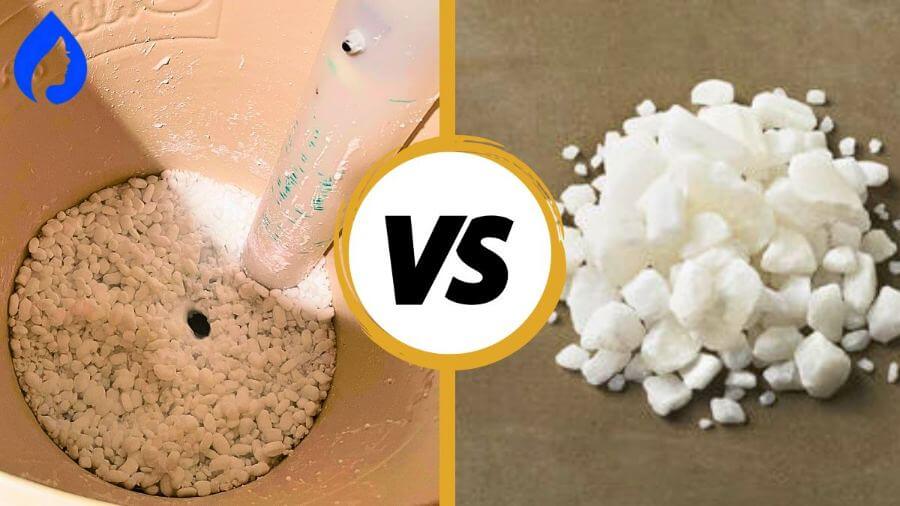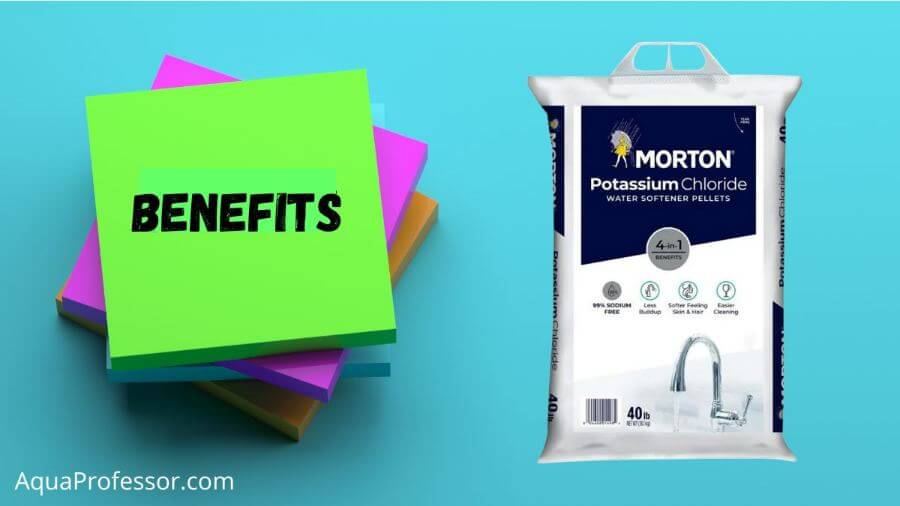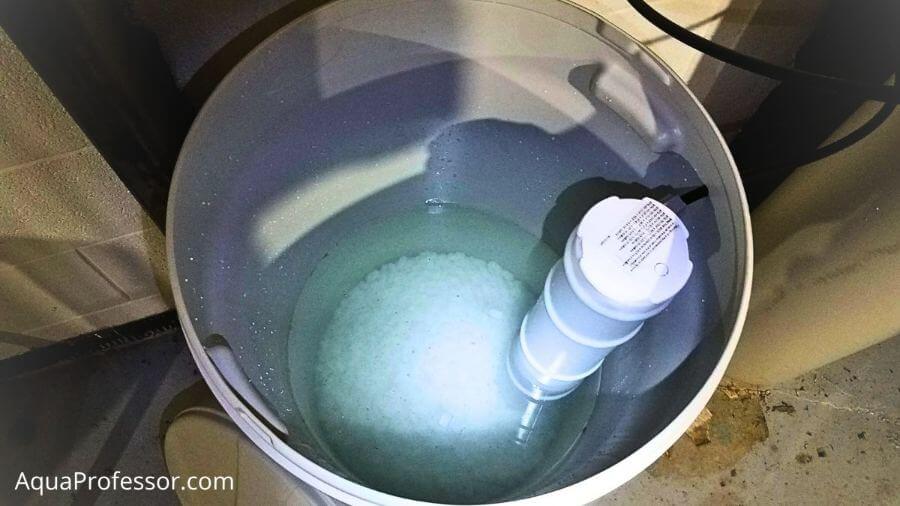
Potassium salt is often seen as an excellent alternative to water-softener salt. But what’s the truth?
Water softener salt is best suited for softening but add sodium to softened water. Potassium chloride doesn’t add sodium and is plant-friendly but costly.
So which one should you opt for? Continue reading for a detailed comparison between water softener salt vs potassium (Spoiler Ahead!)
🤔 Which Is Better, Salt or Potassium, for a Water Softener?
| Basis | Softener Salt (NaCl) | Potassium Chloride (KCl) |
| Softening abilities | Highly effective | Somewhat less effective than NaCl |
| Environmental impact | Less environment friendly as compared to KCl | More environment friendly as compared to NaCl |
| Health impact | Not suitable for individuals having restrictions in sodium intake | Beneficial for health |
| Cost | Cheaper than KCl | Expensive |
✅ Benefits of Potassium Chloride Softeners

🧂 Doesn’t Add Sodium
Potassium Chloride pellets, unlike the general softener salt, never add sodium to the softened water. So, the water softened with the help of KCl is appropriate for even people on a low-sodium diet.
Conversely, potassium-rich water and diet can remove excess sodium, rescuing you from high blood pressure complications.
On the other hand, if you’re using Sodium Chloride salt in your water softener to soften water, you may have to remove sodium from the softened water to control your high blood pressure.
🏃♂️ Great Dietary Supplement
Potassium is a great nutrient that has many health benefits. It helps in:
Consuming softened water with potassium can help you achieve your daily minimum intake, especially if you use soft water for cooking.
🌱 Good For Plants
Using potassium salt makes the softener brine discharge environment-friendly as it helps plants grow, so there is no need to find discharge options.
Note:
Mind you, the world-famous potash fertilizer for plants comes from potassium chloride. As per the report of Agriculture Canada (1995/1996), nearly ninety-four percent of different kinds of domestically used potash originates from potassium chloride.
However, the same is not true for sodium chloride. You can’t water plants from the brine discharge of NaCl-based water softening systems.
❌Potassium Chloride Water Softener Side Effects

Besides, potassium can’t be used in high-humidity regions as it gets hard and makes the water softeners inoperable.
⏩ Should You Be Switching From Salt To Potassium In Water Softener?
Unless you’re on a low-sodium diet because of high blood pressure, switching to potassium-based water softeners doesn’t make sense, as the latter is way more expensive and still less effective for softening.
There are two other cases where using potassium chloride as a regenerant makes sense:
Note:
Increasing potassium intake is not advisable for patients diagnosed with renal issues (kidney disease) or heart medications. So don’t opt for potassium salt if you belong to this category, or consult with your doctor before making the switch.
If you are still going to make the switch to potassium softeners, remember these 2 tips:
🔁 Can You Mix Potassium Chloride and Sodium Chloride in a Water Softener?
Yes, you can mix potassium with salt to cancel the negatives of both. They’re interchangeable as regenerants.
The salts settle in the brine tank once you mix and dissolve them in the water to produce brine. Then, the brine draw pipe passes the brine to the resin tank.
So, whether you pour pellet salt (Potassium chloride) over the crystal salt (sodium chloride) or the crystal salt over the pellet salt, your water softener device will continue to work properly.
Also Read: 6 Common Types Of Water Softener Salt
🥛 Water Softener Salt VS Potassium Chloride: FAQs
🛍 Where to buy potassium chloride for water softener?
You can purchase potassium chloride salt for your water softener from:
1. The manufacturer directly (for example, Morton, Nature’s Own, etc.)
2. Big-box stores (stores with large showrooms)
3. Online marketplaces (Amazon, Flipkart, eBay, etc.)
4. Third-party websites.
Note: Each 40-pound bag of KCl costs approximately 25 to 40 dollars which is 3-4 times more than the water softener salt.
🥛 Is water softened with potassium safe to drink?
Yes, potassium chloride salt is safe to drink. People on sodium-restricted diets can use it to soften their home water and avoid intake of excess sodium from the softened water.
Besides, the potassium nutrient is extremely beneficial for our health. It boosts our immune system and helps maintain our body’s nutritional balance.
🤔 How does a potassium water softener work?
A potassium water softener works in the same way as a sodium water softener. The difference is that potassium chloride softeners replace the hard minerals of the drinking water with potassium ions, whereas sodium water softeners replace them with sodium ions.
Here is how potassium-based water softeners work:
1. Hard water is first allowed to flow through the water softeners.
2. The system’s resin beads absorb the hardness minerals (like calcium and magnesium ions) from the drinking water through ion exchange.
3. As soon as the full absorption capacity of the resin beads is reached, the potassium Chloride salt solution is generated for removing minerals. It washes the resin beads and clears away the mineral scale build-up.
4. The excess minerals and salt solution are set free to drain out of the system.
✅ What Are The Benefits Of Water Softener Salt Over Potassium?
Here are the advantages of water softener salt (NaCl) over KCl:
1. It is highly effective in treating hard water to soften it.
2. Its 4 to 5 times cheaper than KCl
3. It’s required in small quantities as compared to KCl. So, more money is saved.
4. Unlike KCl, NaCl doesn’t produce excess brine.
🧂 What is the best salt type to regenerate ion exchange softener resin?
Evaporated softener salt or NaCl is the best for softener resin regeneration. It is inexpensive, consumes less salt, and doesn’t produce excess brine like its alternatives.
🧐 Can you get too much potassium from a water softener?
Normally, you can’t get too much potassium from a water softener. However, if:
1. The water is too hard
2. Your hardness setting is wrong (potassium salt needs a 25% higher setting than softener salt) improper
3. You’re facing power outages
You can get excess potassium from your water softener.
Adarsh is a Health & Nutrition Sciences graduate with expertise in environmental health. He is associated with ventures like Glacier Fresh Filter and Simpure Filter Systems. Through Aqua Professor, he intends to provide helpful information to every home to help them make smarter decisions.
